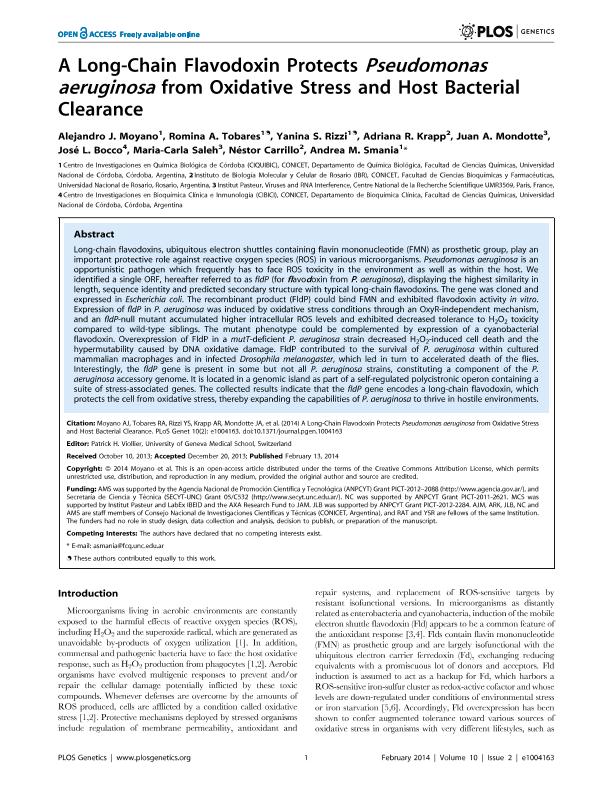Artículo
A Long-Chain Flavodoxin Protects Pseudomonas aeruginosa from Oxidative Stress and Host Bacterial Clearance
Moyano, Alejandro Jose ; Tobares, Romina Alín
; Tobares, Romina Alín ; Rizzi, Yanina
; Rizzi, Yanina ; Krapp, Adriana del Rosario
; Krapp, Adriana del Rosario ; Mondotte, Juan Alberto
; Mondotte, Juan Alberto ; Bocco, Jose Luis
; Bocco, Jose Luis ; Saleh, Maria Carla; Carrillo, Nestor Jose
; Saleh, Maria Carla; Carrillo, Nestor Jose ; Smania, Andrea
; Smania, Andrea
 ; Tobares, Romina Alín
; Tobares, Romina Alín ; Rizzi, Yanina
; Rizzi, Yanina ; Krapp, Adriana del Rosario
; Krapp, Adriana del Rosario ; Mondotte, Juan Alberto
; Mondotte, Juan Alberto ; Bocco, Jose Luis
; Bocco, Jose Luis ; Saleh, Maria Carla; Carrillo, Nestor Jose
; Saleh, Maria Carla; Carrillo, Nestor Jose ; Smania, Andrea
; Smania, Andrea
Fecha de publicación:
02/2014
Editorial:
Public Library Of Science
Revista:
Plos Genetics
ISSN:
1553-7390
e-ISSN:
1553-7404
Idioma:
Inglés
Tipo de recurso:
Artículo publicado
Clasificación temática:
Resumen
Long-chain flavodoxins, ubiquitous electron shuttles containing flavin mononucleotide (FMN) as prosthetic group, play an important protective role against reactive oxygen species (ROS) in various microorganisms. Pseudomonas aeruginosa is an opportunistic pathogen which frequently has to face ROS toxicity in the environment as well as within the host. We identified a single ORF, hereafter referred to as fldP (for flavodoxin from P. aeruginosa), displaying the highest similarity in length, sequence identity and predicted secondary structure with typical long-chain flavodoxins. The gene was cloned and expressed in Escherichia coli. The recombinant product (FldP) could bind FMN and exhibited flavodoxin activity in vitro. Expression of fldP in P. aeruginosa was induced by oxidative stress conditions through an OxyR-independent mechanism, and an fldP-null mutant accumulated higher intracellular ROS levels and exhibited decreased tolerance to H2O2 toxicity compared to wild-type siblings. The mutant phenotype could be complemented by expression of a cyanobacterial flavodoxin. Overexpression of FldP in a mutT-deficient P. aeruginosa strain decreased H2O2-induced cell death and the hypermutability caused by DNA oxidative damage. FldP contributed to the survival of P. aeruginosa within cultured mammalian macrophages and in infected Drosophila melanogaster, which led in turn to accelerated death of the flies. Interestingly, the fldP gene is present in some but not all P. aeruginosa strains, constituting a component of the P. aeruginosa accessory genome. It is located in a genomic island as part of a self-regulated polycistronic operon containing a suite of stress-associated genes. The collected results indicate that the fldP gene encodes a long-chain flavodoxin, which protects the cell from oxidative stress, thereby expanding the capabilities of P. aeruginosa to thrive in hostile environments.
Archivos asociados
Licencia
Identificadores
Colecciones
Articulos(CCT - CORDOBA)
Articulos de CTRO.CIENTIFICO TECNOL.CONICET - CORDOBA
Articulos de CTRO.CIENTIFICO TECNOL.CONICET - CORDOBA
Articulos(IBR)
Articulos de INST.DE BIOLOGIA MOLECULAR Y CELULAR DE ROSARIO
Articulos de INST.DE BIOLOGIA MOLECULAR Y CELULAR DE ROSARIO
Citación
Moyano, Alejandro Jose; Tobares, Romina Alín; Rizzi, Yanina; Krapp, Adriana del Rosario; Mondotte, Juan Alberto; et al.; A Long-Chain Flavodoxin Protects Pseudomonas aeruginosa from Oxidative Stress and Host Bacterial Clearance; Public Library Of Science; Plos Genetics; 10; 2; 2-2014; 1004163-1004163
Compartir
Altmétricas



